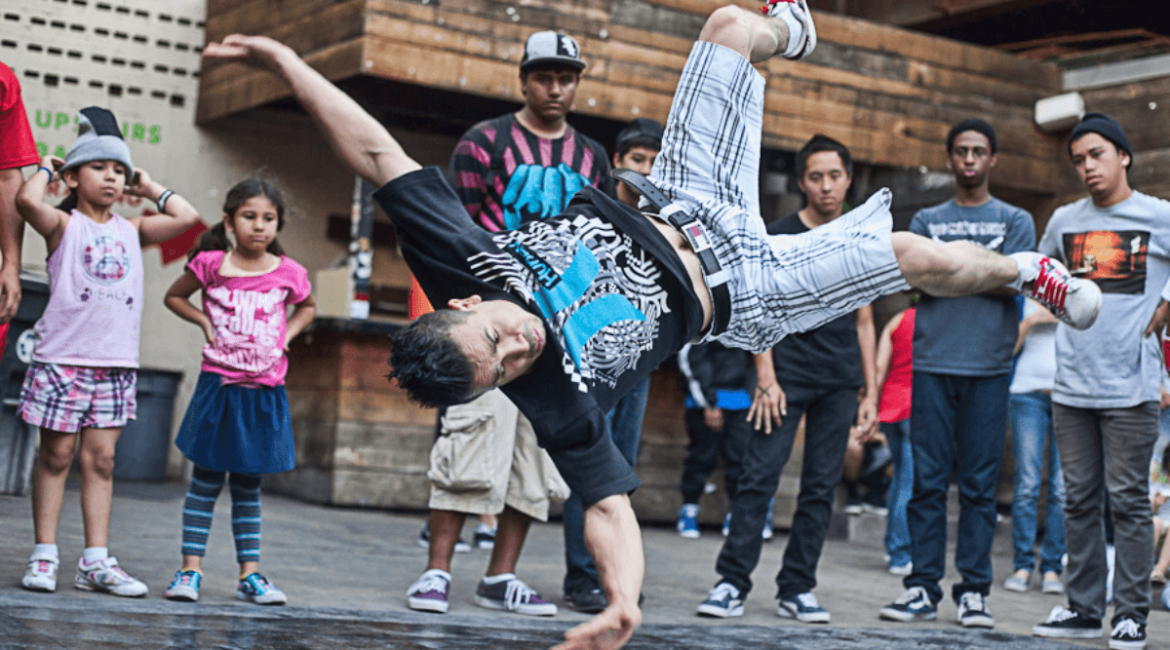In the world of breakdancing, there are certain moves that stand out as iconic symbols of skill, athleticism, and innovation. One such move that has captivated audiences and inspired generations of dancers is the airflare. This dynamic and gravity-defying maneuver is more than just a display of physical prowess; it represents the culmination of years of practice, dedication, and creativity within the breakdancing community.
Imagine a dancer spinning effortlessly through the air, supported only by the strength of their arms and the momentum of their movement. It’s a sight that never fails to impress, leaving spectators in awe of the dancer’s agility and precision. But behind the seemingly effortless execution of the airflare lies a rich history filled with stories of perseverance, ingenuity, and the relentless pursuit of excellence.
In this blog, we’ll delve into the origins of the airflare, exploring its revolution from a niche move practiced by a select few to a staple of modern breakdancing battles and performances around the world.
General information about airflare

Definition
What is airflare? The Airflare, also known as an Airtrack, is an advanced breakdancing move that shares similarities with the Halo or Headtracks. These moves all involve the action of swinging your legs between hand switches, giving them a similar feel.
During an airflare, the breaker is positioned upside down, with their torso tilted at around a 45-degree angle to the floor (though the angle may vary depending on skill level and preference). Their legs are spread out in a V-shape, while their arms remain straight. Throughout the movement, the only body parts touching the floor are the hands.
To execute the airflare, the bboy or bgirl whips their legs and then arms around in a circular path, creating a dynamic and fluid motion. It’s a challenging move that requires both strength and coordination, but mastering it adds an impressive flair to any breaking performance.
Airflare vs Airtrack
Airflares, sometimes known as airtracks, have an interesting history in breakdancing. Originally, airtracks referred to a single 360-degree spin in the air, often used as a transition move to link to another move. However, over time, breakdancers began performing airflares in a continuous manner, similar to the motion of a traditional airtrack. As a result, both terms are now essentially interchangeable, as the difference in execution between the two moves is minimal.
It’s worth noting that while there is a slight variation in the trajectory of the arms (Airflares extend across the chest while airtracks reach over the head), the overall movement and mechanics remain largely the same. Ultimately, whether you refer to it as an airflare or an airtrack, mastering this dynamic move is sure to impress audiences and fellow breakdancers alike.
The history and revolution of airflare
History
States, is credited with being the first to perform a full round of airflares, a groundbreaking powermove in the world of breakdancing. Airflare, an innovative maneuver invented by breakers, quickly gained traction within the dance community. Charles’ crewmate, BBoy Pablo, swiftly picked up the airflare technique from Charles and became a master of the move in no time.
It was during the Freestyle Session-3 in November 1998 that Pablo made history by executing two consecutive Airflares during a battle, thus earning the title of the creator of Multiple airflares. Pablo’s groundbreaking performance marked a significant evolution in breakdancing, introducing advanced transitions and variations with airflares. Prior to the emergence of airflares, the 1990 spin was the primary aerial move for BBoys. However, the introduction of airflares revolutionized the breakdancing scene, providing breakers with newfound freedom and possibilities for aerial transitions.
Revolution
Airflares revolutionized the breakdancing scene, but it wasn’t until around 2007-2008 that B-Boys began incorporating clean one-handed Airflares into their battles, marking a dynamic and innovative variation of the move. This period saw an explosion of creativity and skill as breakers pushed the boundaries of what was possible on the dance floor.
- One notable moment from as early as 2001 is captured in footage of B-Boy Wizel executing a one-handed Airflare to flare transition during a battle. However, mastering this variation was no easy feat, and only a select few B-Boys were able to achieve it with precision and finesse.
- Among these pioneers were B-Boys like Cico from Italy and Punisher from France, who showcased their mastery of the one-handed Airflare with impressive cleanliness and control.
- Fast forward to today, and B-Boys have taken the one-handed Airflare to new heights, with breakers like B-Boy Pocket from Korea and B-Boy C Lil achieving remarkable feats of athleticism and skill.
In recent battles, we’ve witnessed B-Boys performing jaw-dropping sequences of continue one-handed Airflares, pushing the boundaries of what was once thought possible. With each new innovation, the art of breakdancing continues to evolve, inspiring future generations of breakers to push themselves to new heights of creativity and skill.
Paul Hamm, a professional gymnast, made history by becoming the first gymnast to perform Airflares in a gymnastics competition. This groundbreaking moment was met with pride and excitement within the breaking community, as it signaled the acceptance of a move invented by B-Boys into a highly respected sporting event. Similarly, the Thomas flare, a move originating from gymnastics, has found its way into the repertoire of breakdancers around the world.

However, there’s a fascinating story behind the naming of the Airflare in gymnastics competitions.
- During the Olympics, judges encountered the move for the first time and initially announced that they would call it the “Hamminater,” believing that Paul Hamm had innovated it.
- Fortunately, this misunderstanding was quickly resolved when breakers present at the event clarified the origins of the move, and the name “Hamminater” was soon abandoned.
How to do airflare?
Tornado Spin
- Begin by mastering the tornado spin, a foundational technique essential for many power moves.
- Keep your legs wide open and straight while bowing down and touching the floor with your hands and legs one by one.
Star Walk or Hand Spins
- Progress to the star walk or hand spins from the tornado spin.
- Balance on both of your hands while spinning your body, keeping your legs wide open and stretched throughout the movement.
Hop onto Second Hand
- After coming to the pike position, hop onto your second hand.
- Maintain stretched and open legs during this crucial transition step.
Catch Body in Other Hand
- Take a full twist in the air and catch your body in the other hand.
- Ensure that your hand goes over your chest for a stable landing and smooth transition.
Continuous Rounds
- To perform continuous rounds, keep your legs swinging or kicking in the air.
- This requires significant energy and dedication to perfect.
Invest time and effort into mastering the Airflare, as it is a challenging yet rewarding move that showcases both skill and artistry in breakdancing. With perseverance and practice, you’ll soon be soaring through the air with confidence and grace.
Variations of airflare

When it comes to the airflare, the possibilities are endless, with a multitude of variations that showcase the creativity and skill of breakdancers. Let’s explore some of the most notable examples:
Different pattern with the legs
- Bent Leg Air Flares: This variation involves keeping one leg bent throughout the entire movement. Bboys like Blond and The End are renowned for their mastery of this technique, which adds a unique aesthetic to the Airflare.
- Tombstone Air Flares: During the airborne phase of the movement, the legs remain closed and straight, resembling a tombstone shape. This variation adds a sleek and controlled element to the Airflare.
- Munching Air Flares: This variation involves positioning the legs in a munch-mill position mid-flight, creating a unique “munch” effect. In advanced variations, dancers maintain this leg position even when their hands are in contact with the ground.
- Threaded Air Flares: Dancers bring one leg through a loop created by the other leg and the non-supporting hand, adding a dynamic and intricate element to the Airflare.
- Lotus Air Flares: Similar to a regular Airflare, but with the legs positioned in a lotus position, adding a visually striking and intricate twist to the move.
Different pattern with the hands
- Elbow Air Flares/Elbow Tracks: Instead of using their hands, dancers execute the Airflare using their elbows for support, adding an extra level of challenge and flair to the move.
- Hopping Air Flares: In this variation, both hands never touch the ground simultaneously. Dancers utilize a hopping motion to transition from one hand to the other, sometimes incorporating bent legs to enhance the hopping effect.
- Walking Air Flares: In this challenging variation, at least one hand maintains contact with the ground throughout the movement, requiring exceptional shoulder flexibility and control.
- One-handed Air Flares: Arguably one of the most difficult variations, dancers execute a full swing with only one hand, rotating 180 degrees. Renowned breakers like Punisher and C Lil have mastered this impressive feat.
- Airflare 1.5 (a.k.a. Airflare Bombs, Airflare suicides): In this variation, the body rotates 540 degrees, and the dancer lands on their back rather than on their hands, adding a daring and acrobatic twist to the traditional Airflare.
These variations showcase the versatility and innovation of breakdancers, pushing the boundaries of what’s possible in the world of breakdancing. Whether it’s adding extra flair or testing the limits of athleticism, each variation brings its own unique style and challenge to the airflare.
If you want to see conquer this cool breakdance move, watch this YOUTUBE video for more tips to do airflare successfully!


Leave a reply